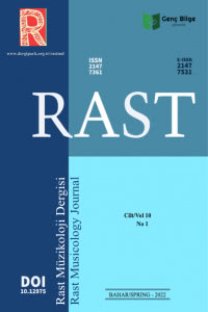The “Time-Makam Analysis Model” as a graphic notation: A playful tool for collaborative improvised music
This study seeks to explore the creative performing processes that arise from the use of graphic scores. To achieve this, it uses the Time-Makam Analysis Model to demonstrate how this type of notation can produce “playful” creative processes that are open to evaluation from an ethnomusicological perspective. The study presents a practical, experimental, and multidisciplinary approach to graphic notation, it discusses the individual and collective relationships that performers have with a score of this type, and examines the spontaneous decision-making processes involved. The study is also intended to support performers’ collective creative decision-making, their playful thinking, and their improvisational skills. First, the introduction gives an overview of the concept of notation and provides a historical perspective for contemporary graphic scores. This is followed by an examination of the Time-Makam Analysis Model and its association with graphic notation, and a psychological discussion of creative, playful thinking processes. The final section contains field notes from two performances in which the author of this study took part: an online recording by the SAVT improvisation trio (Elif Canfeza Gündüz classical kemenche, Merve Salgar tanbur, and Zeynep Ayşe Hatipoğlu violoncello) and a real time collaboration with Ülkü Çağlayan (body movement and violoncello).
Anahtar Kelimeler:
graphic notation, time-makam analysis model, collaboration, improvised music, playful thinking
The “Time-Makam Analysis Model” as a graphic notation: A playful tool for collaborative improvised music
This study seeks to explore the creative performing processes that arise from the use of graphic scores. To achieve this, it uses the Time-Makam Analysis Model to demonstrate how this type of notation can produce “playful” creative processes that are open to evaluation from an ethnomusicological perspective. The study presents a practical, experimental, and multidisciplinary approach to graphic notation, it discusses the individual and collective relationships that performers have with a score of this type, and examines the spontaneous decision-making processes involved. The study is also intended to support performers’ collective creative decision-making, their playful thinking, and their improvisational skills. First, the introduction gives an overview of the concept of notation and provides a historical perspective for contemporary graphic scores. This is followed by an examination of the Time-Makam Analysis Model and its association with graphic notation, and a psychological discussion of creative, playful thinking processes. The final section contains field notes from two performances in which the author of this study took part: an online recording by the SAVT improvisation trio (Elif Canfeza Gündüz classical kemenche, Merve Salgar tanbur, and Zeynep Ayşe Hatipoğlu violoncello) and a real time collaboration with Ülkü Çağlayan (body movement and violoncello).
Keywords:
graphic notation, collaboration, improvised music, playful thinking, time-makam analysis model,
___
- Baysal, Ozan. 2018. ”Zaman Makam Analiz Modeli” 9th International Hisarlı Ahmet Symposium, (10-12 May):298-313. https://hisarliahmet.org/img/covers/2018proc.pdf.
- Barnett A., Lynn. 2011-2012. “Playful People: “Fun Is In The Mind Of The Beholder”. Imagination, Cognition and Personality, Vol. 31(3), 169-197 https://journals.sagepub.com/doi/10.2190/IC.31.3.c
- Bhagwati, Sandeep. 2013.“Notational Perspective and Comprovisation” In Sound & Score Essays on Sound, Score and Notation, eds. Paulo de Assis , William Brooks, Kathleen Coessens, Chapter 11, 165-177. Belgium: Leuven University Press.
- Cage, John. 1969. Notations. New York: Something Else Press.
- Cox, Christopher, and Warner, Daniel. eds. 2017. “IV. The Open Work, Introduction”, 462- 65. In Audio Culture, Revised Edition: Readings in Modern Music. USA, UK: Bloomsbury Publishing
- Girgin Tohumcu, Z. Gonca. 2006. Müziği Yazmak Müzik Notasyonunun Tarih İçinde Yolculuğu. Istanbul: Nota Yayıncılık.
- Hatipoğlu, Zeynep Ayşe. 2021. “Doğaçlamada Yaratıcılık ve Tanburi Cemil Bey: Zaman-Makam Analiz Modeli Üzerinden Yeni Bir Doğaçlama Yorumu” 150th Birth Anniversary “Üstâd-ı Cihan” Tanburi Cemil Bey International Online Symposium, Symposium Program&Abstracts (7-9 May): 52. https://tumac.org/wp-content/uploads/2021/05/TUMAC_TCBS_Program_Bildiri_Ozetleri.pdf
- Groove Music Online. Published online 2001, Updated and Revised 2014.“Notation”, Accessed February 20, 2022. https://doi.org/10.1093/gmo/9781561592630.article.20114
- Hatipoglu, Z. A., Baysal O. 2017. Tanburi Cemil Bey’s Bestenigar Yayli Tanbur and Violoncello Taksims Comparative Time Analysis. In Tanburi Cemil Bey: Symposium Declarations edited by Baran, Hasan and Abbasıoğlu Yıldız, Zeynep. Istanbul: Küre Publishing.
- Hatipoglu, Z.A., Baysal O., 2016. Structural Planning In Tanburi Cemil Bey’s Bestenigar, Huseyni and Ussak Cello Taksims, In The100. Death Anniversary a Gift for Tanburi Cemil Bey, 135-146, Istanbul Metropolitan Municipality Publications.
- Kunter, Yeşim. 2016. “What is Play?” Last modified November 27, 2016. Accessed February 20, 2022. https://www.playtoinnovate.com/what-is-play/.
- Lieberman, J. Nina. 1977. Educational Psychology Series, Playfulness Its Relationship to Imagination and Creativity. New York: Academic Press, INC. Johan Huizinga (1872-1945), wrote his book ‘Homo Ludens’ in 1938.
- Sauer, Theresa. 2009. Notations 21. New York: Mark Batty Publisher
- Thoreau, Henry David. 2016. “Walking.” In The Making of the American Essay, edited by John D’Agata, 167–95. Minneapolis: Graywolf Press.
- Yale University. n.d. “About Yale: Yale Facts.” Accessed May 1, 2017. https://www.yale.edu/about-yale/yale-facts.
- ISSN: 2147-7361
- Yayın Aralığı: Yılda 4 Sayı
- Başlangıç: 2013
- Yayıncı: Genç Bilge Yayıncılık (Young Wise)
Sayıdaki Diğer Makaleler
Analysis and comparison of most popular piano teaching method in Iran
Mahdi SOLİEMANİ RAD, Pooyan AZADEH
An analysis of the polyphonic Georgian folk song “Maqruli” performed by Machakheli Seniors’ Ensemble
Damla ŞAHİN, Sernaz DEMİREL TEMEL
Ali Orhan DÖNMEZ, N. Fikri SOYSAL
Automatic musical transcription of the Tatar folk song: comparative analysis of AI-powered programs
Liliya BORODOVSKAYA, Ziliya YAVGİLDİNA, Elena DYGANOVA, Larisa MAYKOVSKAYA, Irina MEDVEDEVA
Divân-ı Kebîr’de yer alan rebap çalgısına yönelik metaforların hermeneutik açıdan incelenmesi
Fulya SOYLU BAĞÇECİ, Mücahit ÖZDEMİR
Gülcan ERTAN HACISÜLEYMANOĞLU, Turan SAĞER
